Topics
Sexual Reproduction in Flowering Plants
- Flower - a Fascinating Organ of Angiosperms
- Parts of Flower
- Accessory Organs
- Essential Parts of Flower: Androecium
- Essential Parts of Flower: Gynoecium
- Sexual Reproduction in Flowering Plants
- Pre-fertilisation in Flowering Plant: Structures and Events
- Development of Anther
- Transverse Section of Mature Anther (Microsporangium)
- Microsporogenesis
- Microspores and Pollen Grains
- Development of Male Gametophyte
- Advantages and Disadvantages of Pollen Grains
- Structure of Ovule (Megasporangium)
- Types of Ovules
- Megasporogenesis
- Development of Female Gametophyte or Embryo Sac
- Pollination
- Outbreeding Devices
- Artificial Hybridization
- Kinds of Pollination
- Self Pollination (Autogamy)
- Cross Pollination
- Agents of Pollination
- Abiotic Agents
- Biotic Agents
- Fertilization Process
- Fertilization Process
- Post Fertilisation in Plant: Structures and Events
- Development of Endosperm
- Post Fertilization in Plant: Development of Embryo (Embryogeny)
- Development of Seed
- Development of Fruit
- Apomixis
- Polyembryony
Reproduction in Organisms
- Life Span of Organisms
- Maximum Life Span of Organisms
- Reproduction in Organisms
- Types of Reproduction
- Asexual Reproduction
- Sexual Reproduction in Animals
- Asexual Reproduction in Plant
- Asexual Reproduction in Animal
- Budding
- Vegetative Reproduction
- Natural Vegetative Reproduction
- Artificial Vegetative Reproduction
- Artificial Vegetative Reproduction
- Artificial Vegetative Reproduction
- Fission
- Budding
- Sporulation (Sporogenesis)
- Fragmentation
- Different Phases in Sexual Reproduction
- Sexual Reproduction in Animals
- Pre-fertilisation Events in Organisms
- Fertilisation in Organisms
- Post-fertilisation Events in Organisms
Reproduction
Genetics and Evolution
Human Reproduction
Reproductive Health
Biology and Human Welfare
Environmental Issues
- Environmental Issues
- Prevention of Air Pollution
- Controlling Vehicular Air Pollution: a Case Study of Delhi
- Introduction of Water Pollution and Its Control
- Effects of Domestic Sewage and Industrial Effluents on Water
- A Case Study of Integrated Waste Water Treatment
- Solid Wastes
- Agrochemicals and Their Effects
- Radioactive Wastes
- Greenhouse Effect and Climate Change
- Ozone Depletion in the Stratosphere
- Degradation by Improper Resource Utilisation and Maintenance
- Deforestation and Its Causes
- Radioactive Waste Management and E-waste
- Solid Waste Management
- Noise Pollution
- Environmental Issues
Biotechnology
Principles of Inheritance and Variation
- Introduction of Principles of Inheritance and Variation
- Mendelism
- Terminology Related to Mendelism
- Mendel’s experiments on pea plant
- Monohybrid Cross
- Gregor Johann Mendel – Father of Genetics
- Punnett Square
- Back Cross and Test Cross
- Mendelian Inheritance - Mendel’s Law of Heredity
- The Law of Dominance
- The Law of Segregation (Law of Purity of Gametes)
- The Law of Independent Assortment
- Intragenic Interactions - Incomplete Dominance
- Intragenic Interactions - Codominance
- Gregor Johann Mendel – Father of Genetics
- Extensions of Mendelian Genetics (Deviation from Mendelism)
- Intragenic Interactions - Incomplete Dominance
- Intragenic Interactions - Dominance
- Intragenic Interactions - Codominance
- Multiple Alleles
- Intragenic Interactions - Pleiotropy
- Polygenic Inheritance
- Chromosomal Theory of Inheritance
- Historical Development of Chromosome Theory
- Comparison Between Gene and Chromosome Behaviour
- Chromosomal Theory of Inheritance: Law of Segregation
- Chromosomal Theory of Inheritance: Law of Independent Assortment
- Linkage and Recombination
- Sex Determination
- Sex Determination in Some Insects
- Sex Determination in Human
- Sex Determination in Birds
- Sex Determination in Honey Bees
- Concept of Mutation
- Pedigree Analysis
- Genetic Disorders
- Mendelian Genetics
- Chromosomal Abnormalities
- Heredity and Variation
- Linkage and Crossing Over
- Principles of Inheritance and Variation Question
Molecular Basis of Inheritance
- Introduction of Molecular Basis of Inheritance
- Deoxyribonucleic Acid (DNA) and Its Structure
- Structure of Polynucleotide Chain
- Packaging of DNA Helix
- Search for Genetic Material
- Introduction of Search for Genetic Material
- The Genetic Material is a DNA
- Properties of Genetic Material (DNA Versus RNA)
- The RNA World
- DNA Replication
- The Experimental Proof
- The Machinery and the Enzymes
- Protein Synthesis
- Introduction of Transcription
- Transcription Unit
- Transcription Unit and the Gene
- Types of RNA and the Process of Transcription
- Genetic Code
- Genetic Code
- Genetic Code
- tRNA – the Adapter Molecule
- Translation
- Regulation of Gene Expression
- Operon Concept
- Human Genome Project
- DNA Fingerprinting Technique
- Structure of DNA and RNA
- Structure of Nucleotide
- Rice Genome Project
- Molecular Basis of Inheritance (Questions)
Ecology
Evolution
- Origin and Evolution of Universe and Earth
- Theories of Origin of Life
- Evolution of Life Forms - a Theory
- Evidences for Biological Evolution
- Theories of Biological Evolution
- Adaptive Radiation
- Organic Evolution
- Hardy Weinberg’s Principle
- Brief Account of Evolution
- Human Evolution
- Darwinism
- Micro and Macro Evolution
- Speciation
- Evolution Stages
- Modern Synthetic Theory of Evolution
- Gene Flow and Genetic Drift
- Evolution
Human Health and Diseases
- Introduction of Human Health and Diseases
- Common Diseases in Human Beings
- Immunity
- Types of Immunity
- Vaccination and Immunization
- Allergies (Hypersensitivity)
- Autoimmunity
- Human Immune System
- Sexually Transmitted Diseases (STD)
- Cancer
- Introduction of Drugs and Alcohol Abuse
- Drugs and Alcohol Abuse
- Adolescence - Drug and Alcohol Abuse
- Addiction and Dependence
- Effects of Drug and Alcohol
- Prevention and Control of Drugs and Alcohol Abuse
- Infectious and Non Infectious Disease
- Maintaining Good Health, Yoga, Excercise
- Human Health and Diseases (Questions)
Strategies for Enhancement in Food Production
Microbes in Human Welfare
- Microbes in Human Welfare
- Microbes in Household Products
- Microbes in Industrial Production
- Microbes in Sewage Treatment
- Microbes in Production of Biogas
- Microbes as Biocontrol Agents
- Microbes as Biofertilizers
- Energy Generation
- Production and Judicious Use
- Microbes in Human Welfare
Biotechnology - Principles and Processes
- Process and Principles of Biotechnology
- Restriction Enzymes
- Cloning Vectors
- Competent Host (For Transformation with Recombinant DNA)
- Processes of Recombinant DNA Technology
Biotechnology and Its Application
Organisms and Populations
- Introduction of Organisms and Populations
- Ecology (Organism, Population, Community and Biome)
- Introduction of Organisms and Environment
- Major Abiotic Factors
- Responses to Abiotic Factors
- Population Attributes
- Population Growth
- Life History Variation
- Population Interactions
- Population and Ecological Adaptations
- Organisms and Populations (Questions)
Ecosystem
- Ecosystem
- Introduction and Types of Ecosystem
- Ecosystem - Structure and Function
- Productivity
- Decomposition
- Concept of Energy Flow in an Ecosystem
- Ecological Pyramids
- Ecological Succession
- Nutrient Cycles
- Ecosystem Services
- Ecosystems Patterns
Biodiversity and Its Conservation
- Biodiversity
- Species on Earth and Species in India
- Patterns of Biodiversity
- Importance of Species Diversity to the Ecosystem
- Loss of Biodiversity
- Conservation of Biodiversity
- Endangered Organisms
- Importance of Biodiversity
- Extinction
- Red Data Book
- Biodiversity and Its Conservation (Questions)
- Pre-fertilisation Events in Organisms:
- Gametogenesis - Sexuality in organisms, Cell division during gamete formation
- Gamete Transfer
Notes
Pre-fertilisation Events in Organisms:
- These include all the events of sexual reproduction prior to the fusion of gametes.
- The two main pre-fertilisation events are gametogenesis and gamete transfer.
Notes
A) Gametogenesis:
- Gametogenesis refers to the process of formation of the two types of gametes – male and female.
- Gametes are haploid cells. Gametes divide into two types -
a) Homogametes (isogametes): The two gametes are similar so it is not possible to classify them as male or as female gametes. Therefore, they are called homogametes (isogametes). For example - some algae like Cladophora.
b) Heterogametes: As in the majority of sexually reproducing organisms, the gametes produced are of two morphologically distinct types and are known as heterogametes. The male gamete is called an antherozoid (sperm or microgametes) and the female gamete is called an egg (ovum or macrogametes). For example Fucus (an alga) and Homo sapiens (Human beings).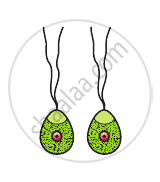
Isogametes of Cladophora
(an alga)
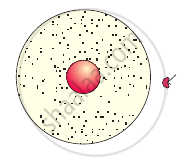
Heterogametes of Fucus
(an alga)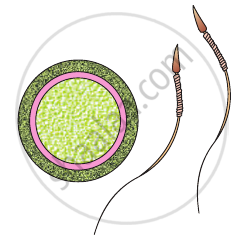
Heterogametes of Homo sapiens
(Human beings)
Sexuality in organisms:
- Sexual reproduction in organisms, in general, involves the fusion of gametes from two different individuals. But this is not always true.
- Bisexual: Both male and female reproductive structures are present in the same individual.
(i) Bisexual Plants and Fungi: Both male and female reproductive structures are present in the same plant. In several fungi and plants, terms such as homothallic and monoecious are used to denote the bisexual condition. In some flowering plants, both male and female flowers may be present on the same individual, it is called monoecious. Some examples of monoecious plants are cucurbits and coconuts.
(ii) Bisexual animals: Both male and female reproductive organs, are hermaphrodites. Earthworms, sponges, tapeworms and leech, are typical examples of bisexual animals.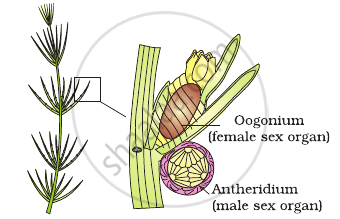
Monoecious plant (Chara)

Bisexual flower (sweet potato)
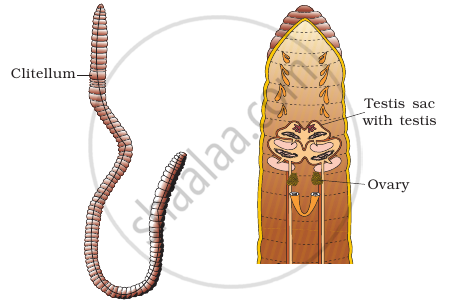
Bisexual animal (Earthworm)
- Unisexual: Male and female reproductive structures are present in different individuals.
(i) Unisexual Plants and Fungi: Both male and female reproductive structures are present in the different plants, it is called unisexual plants. In several fungi and plants, Heterothallic and dioecious are the terms used to describe unisexual conditions. In flowering plants, the unisexual male flower is staminate, i.e., bearing stamens, while the female is pistillate or bearing pistils. In some flowering plants, both male and female flowers may be present on separate individuals, it is called dioecious. Some examples of dioecious plants are papaya and date palm.
(ii) Unisexual Animals: The cockroach, ant, wasps, bees and humans, are examples of a unisexual species.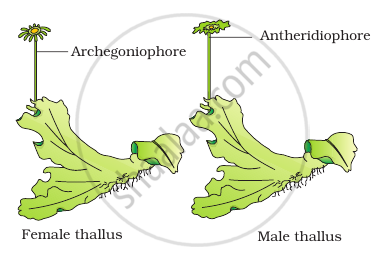
Dioecious plant (Marchantia)
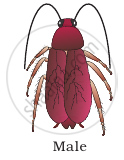
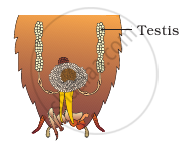

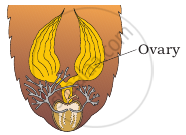
Unisexual animal (Cockroach)
Cell division during gamete formation:
-
A haploid parent produces gametes by mitotic division.
-
Several organisms belonging to monera, fungi, algae and bryophytes have haploid plant body, but for organisms belonging to pteridophytes, gymnosperms, angiosperms and most of the animals including human beings, the parental body is diploid. It is obvious that meiosis, the reduction division, has to occur if a diploid body has to produce haploid gametes.
-
In diploid organisms, specialized cells called meiocytes (gamete mother cells) undergo meiosis. At the end of meiosis, only one set of chromosomes gets incorporated into each gamete.
| Chromosome Numbers in Meiocytes (diploid, 2n) and Gametes (haploid, n) of Some Organisms | ||
| Plants | ||
| Name of organism | Chromosome number in meiocyte (2n) | Chromosome number in gamete (n) |
| Onion | 32 | 16 |
| Potato | 48 | 24 |
| Maize | 20 | 10 |
| Rice | 24 | 12 |
| Apple | 34 | 17 |
| Ophioglossum (a fern) | 1260 | 630 |
| Animals | ||
| Human beings | 46 | 23 |
| Housefly | 12 | 6 |
| Rat | 42 | 21 |
| Dog | 78 | 39 |
| Cat | 38 | 19 |
| Fruitfly | 8 | 4 |
| Butterfly | 380 | 190 |
Notes
(B) Gamete Transfer:
- Male gametes need a medium to move towards female gametes for fertilisation. In a majority of organisms, the male gamete is motile and the female gamete is stationary.
- Exceptions are a few fungi and algae in which both types of gametes are motile.
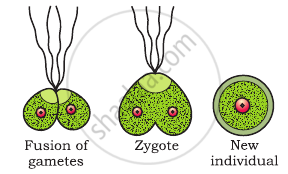
Homogametic contact in alga
- In several simple plants like algae, bryophytes and pteridophytes, water is the medium through which this gamete transfer takes place. A large number of the male gametes, however, fail to reach the female gametes. To compensate for this loss of male gametes during transport, the number of male gametes produced is several thousand times the number of female gametes produced.
-
In seed plants, pollen grains are the carriers of male gametes and the ovule has the egg. Pollen grains produced in anthers have to be transferred to the stigma before it can lead to fertilisation.

Germinating pollen grains on the stigma of a flower
-
In bisexual, self-fertilizing plants, e.g., peas, transfer of pollen grains to the stigma is relatively easy as anthers and stigma are located close to each other. Pollen grains soon after they are shed, come in contact with the stigma. But in cross-pollinating plants (including dioecious plants), pollination facilitates the transfer of pollen grains to the stigma. Pollen grains germinate on the stigma and the pollen tubes carrying the male gametes reach the ovule and discharge male gametes near the egg.
- In dioecious animals, since male and female gametes are formed in different individuals, the organism must evolve a special mechanism for gamete transfer. Successful transfer and coming together of gametes is essential for the most critical event in sexual reproduction, the fertilisation.
If you would like to contribute notes or other learning material, please submit them using the button below.
Shaalaa.com | Sexual Reproduction: Juvenile Reproduction
to track your progress
Related QuestionsVIEW ALL [49]
| Fertilisation is the key process in sexually reproducing organisms and it acts as a vital link between two generations. Flowering plants adopt a unique pattern of sexual reproduction as compared to other organisms. |
- Explain the process of fertilisation in angiosperms.
- What is the precise location and function of filiform apparatus in the embryo sac of angiosperms?
- Fruits and seeds are generally formed due to fertilisation. Name the process involved in the production of the following without fertilisation:
- Fruits
- Seeds
